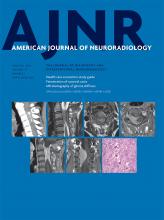Index by author
Benzakoun, J.
- FELLOWS' JOURNAL CLUBAdult BrainYou have accessDo Fluid-Attenuated Inversion Recovery Vascular Hyperintensities Represent Good Collaterals before Reperfusion Therapy?E. Mahdjoub, G. Turc, L. Legrand, J. Benzakoun, M. Edjlali, P. Seners, S. Charron, W. Ben Hassen, O. Naggara, J.-F. Meder, J.-L. Mas, J.-C. Baron and C. OppenheimAmerican Journal of Neuroradiology January 2018, 39 (1) 77-83; DOI: https://doi.org/10.3174/ajnr.A5431
The authors evaluated 244 consecutive patients eligible for reperfusion therapy with MCA stroke and pretreatment MR imaging with both FLAIR and PWI. The FLAIR vascular hyperintensity score was based on ASPECTS, ranging from 0 (no FLAIR vascular hyperintensity) to 7 (FLAIR vascular hyperintensities abutting all ASPECTS cortical areas). The hypoperfusion intensity ratio was defined as the ratio of the time-to-maximum >10-second over time-to-maximum >6-second lesion volumes. The FLAIR vascular hyperintensities were more extensive in patients with good collaterals than those with poor collaterals. The FLAIR vascular hyperintensity score was independently associated with good collaterals. They conclude that the ASPECTS assessment of FLAIR vascular hyperintensities could be used to rapidly identify patients more likely to benefit from reperfusion therapy.
Berlis, A.
- FELLOWS' JOURNAL CLUBInterventionalYou have accessTwo-Center Experience in the Endovascular Treatment of Ruptured and Unruptured Intracranial Aneurysms Using the WEB Device: A Retrospective AnalysisJ. Popielski, A. Berlis, W. Weber and S. FischerAmerican Journal of Neuroradiology January 2018, 39 (1) 111-117; DOI: https://doi.org/10.3174/ajnr.A5413
The authors performed a retrospective analysis of all ruptured and unruptured aneurysms treated with a WEB device between August 2014 and February 2017. Primary outcome measures included the feasibility of implantation and the angiographic outcome. Secondary outcome measures included the clinical outcome at discharge and procedural complications. One hundred two aneurysms in 101 patients, including 37 (36.3%) ruptured aneurysms, were treated with the WEB device. Implantation was successful in 98 (96.1%) aneurysms. Additional devices (stents/coils) were necessary in 15.3% (15/98) of aneurysms. Delayed aneurysm ruptures have not been observed during the follow-up period to date. They conclude that the WEB device offers a safe and effective treatment option for broad-based intracranial aneurysms without the need for dual antiplatelet therapy.
Biagi, L.
- Adult BrainOpen AccessSemiautomated Evaluation of the Primary Motor Cortex in Patients with Amyotrophic Lateral Sclerosis at 3TG. Donatelli, A. Retico, E. Caldarazzo Ienco, P. Cecchi, M. Costagli, D. Frosini, L. Biagi, M. Tosetti, G. Siciliano and M. CosottiniAmerican Journal of Neuroradiology January 2018, 39 (1) 63-69; DOI: https://doi.org/10.3174/ajnr.A5423
Bowen, B.
- Peripheral Nervous SystemYou have accessGadolinium DTPA Enhancement Characteristics of the Rat Sciatic Nerve after Crush Injury at 4.7TB.J. Hill, K.R. Padgett, V. Kalra, A. Marcillo, B. Bowen, P. Pattany, D. Dietrich and R. QuencerAmerican Journal of Neuroradiology January 2018, 39 (1) 177-183; DOI: https://doi.org/10.3174/ajnr.A5437
Brennan, P.
- InterventionalOpen AccessTime for a Time Window Extension: Insights from Late Presenters in the ESCAPE TrialJ.W. Evans, B.R. Graham, P. Pordeli, F.S. Al-Ajlan, R. Willinsky, W.J. Montanera, J.L. Rempel, A. Shuaib, P. Brennan, D. Williams, D. Roy, A.Y. Poppe, T.G. Jovin, T. Devlin, B.W. Baxter, T. Krings, F.L. Silver, D.F. Frei, C. Fanale, D. Tampieri, J. Teitelbaum, D. Iancu, J. Shankar, P.A. Barber, A.M. Demchuk, M. Goyal, M.D. Hill and B.K. Menon for the ESCAPE Trial InvestigatorsAmerican Journal of Neuroradiology January 2018, 39 (1) 102-106; DOI: https://doi.org/10.3174/ajnr.A5462
Bronge, L.
- Adult BrainOpen AccessPerivascular Spaces in Old Age: Assessment, Distribution, and Correlation with White Matter HyperintensitiesA. Laveskog, R. Wang, L. Bronge, L.-O. Wahlund and C. QiuAmerican Journal of Neuroradiology January 2018, 39 (1) 70-76; DOI: https://doi.org/10.3174/ajnr.A5455
Bruce, R.J.
- FELLOWS' JOURNAL CLUBPediatric NeuroimagingYou have accessDeep Brain Nuclei T1 Shortening after Gadobenate Dimeglumine in Children: Influence of Radiation and ChemotherapyS. Kinner, T.B. Schubert, R.J. Bruce, S.L. Rebsamen, C.A. Diamond, S.B. Reeder and H.A. RowleyAmerican Journal of Neuroradiology January 2018, 39 (1) 24-30; DOI: https://doi.org/10.3174/ajnr.A5453
The authors reviewed clinical charts and images of patients 18 years of age or younger with ≥4 gadobenatedimeglumine–enhanced MRIs for 6 years. Seventy-six children (60 unconfounded by treatment, 16 with radiochemotherapy) met the selection criteria. T1 signal intensity ratios for the dentate to pons and globus pallidus to thalamus were calculated and correlated with number of injections, time interval, and therapy. Among the 60 children without radiochemotherapy, only 2 had elevated T1 signal intensity ratios. Twelve of the 16 children with radiochemotherapy showed elevated signal intensity ratios. Statistical analysis demonstrated a significant signal intensity ratio change for the number of injections. Compared with published adult series, children show a similar pattern of T1 hyperintense signal changes of the dentate and globus pallidus after multiple gadobenatedimeglumine injections. The T1 signal changes in children are accelerated by radiochemotherapy.
Caldarazzo Ienco, E.
- Adult BrainOpen AccessSemiautomated Evaluation of the Primary Motor Cortex in Patients with Amyotrophic Lateral Sclerosis at 3TG. Donatelli, A. Retico, E. Caldarazzo Ienco, P. Cecchi, M. Costagli, D. Frosini, L. Biagi, M. Tosetti, G. Siciliano and M. CosottiniAmerican Journal of Neuroradiology January 2018, 39 (1) 63-69; DOI: https://doi.org/10.3174/ajnr.A5423
Cantrell, C.G.
- Adult BrainOpen AccessSpatial Correlation of Pathology and Perfusion Changes within the Cortex and White Matter in Multiple SclerosisA.D. Mulholland, R. Vitorino, S.-P. Hojjat, A.Y. Ma, L. Zhang, L. Lee, T.J. Carroll, C.G. Cantrell, C.R. Figley and R.I. AvivAmerican Journal of Neuroradiology January 2018, 39 (1) 91-96; DOI: https://doi.org/10.3174/ajnr.A5410
Cao, W.
- InterventionalOpen AccessHemodynamic Changes Caused by Multiple Stenting in Vertebral Artery Fusiform Aneurysms: A Patient-Specific Computational Fluid Dynamics StudyN. Lv, W. Cao, I. Larrabide, C. Karmonik, D. Zhu, J. Liu, Q. Huang and Y. FangAmerican Journal of Neuroradiology January 2018, 39 (1) 118-122; DOI: https://doi.org/10.3174/ajnr.A5452








